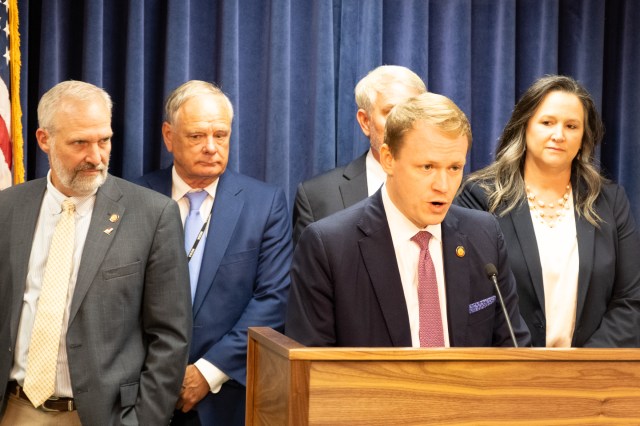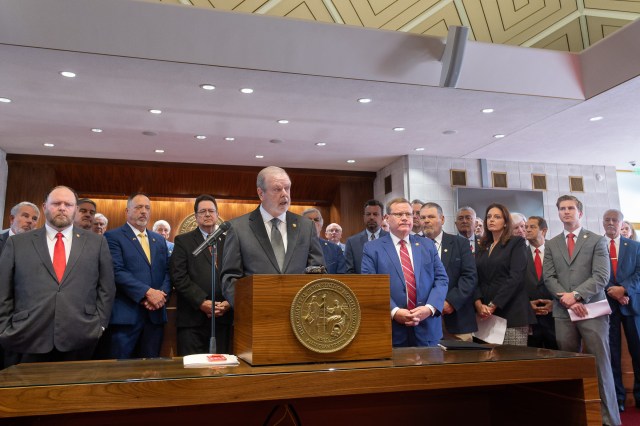Stay ahead of the curve as a political insider with deep policy analysis, daily briefings and policy-shaping tools.
Request a DemoCutting students’ chronic absenteeism rates poses challenge for state leaders

- Chronic student absenteeism spiked during and after the pandemic
- Education leaders say state officials need to lead the charge
- A challenge is to convince parents of the importance of everyday attendance
Education professionals at an American Enterprise Institute event Wednesday issued a clarion call to state leaders and school districts around the country to cut students’ chronic absenteeism by 50% over the next five years.
Chronic absenteeism is defined as missing 10% of the school year, equivalent to at least 18 calendar days.
Nat Malkus, deputy director of education policy studies at American Enterprise Institute, said this nonpartisan goal remains the most urgent issue facing schools today.
“It’s necessary because leadership at the top needs to raise this as the top priority for this school year,” Malkus said. “This is not something to start in on in December. … This is one of those places where the bully pulpit at the state level can raise priorities, and that can trickle down. So, yes, districts need the support and the pressure from states to turn this around.”
The goal of cutting the rate by 50% over the next five years is ambitious, audacious and aspirational but achievable, according to Denise Forte, president of The Education Trust, a nonprofit organization committed to advancing policies to dismantle racial and economic barriers in the American education system.
In 2019, 15% of K-12 students in the United States were considered chronically absent, Malkus said, according to data collected by the Return 2 Learn Tracker.
“Pre-pandemic, chronic absenteeism was not a minor issue,” Malkus said. “Chronic absenteeism is related just to a bevy of negative effects. It’s not complicated — I think schools are good. I think being in schools consistently is good, and the data bears this out.”
Data for the 2020 and 2021 school years remains difficult to track due to the lack of in-person learning. In 2022, rates for chronic absenteeism skyrocketed to 90% across the country.
“I’m a data guy. I do all kinds of education data,” Malkus said. “I’ve never seen anything like it. …. There’s no jurisdiction or state that didn’t increase dramatically.”’
While no state was immune to the effects of the COVID-19 pandemic, chronic absenteeism reflected existing gaps between high- and low-achieving schools, with lower-performing schools having lower regular student attendance.
Hedy Chang, executive director of Attendance Works, a national initiative aimed at advancing student success by addressing chronic absence, noted that while absenteeism rates in many school districts are slowly recovering, some are getting worse. Another challenge for policymakers, Chang noted, is the difficulty of comparing rates across states that define chronic absenteeism or what constitutes a regular school day differently.
“This is the real threat that we’re looking at now — is that if chronic absenteeism doesn’t go back down, it becomes a new normal,” Malkus said about a post-pandemic casualness that has taken root.
It’s going to take more than just a political response, according to Malkus, but a sustained cultural response that parents can buy into and reestablish learning and regular attendance as priorities.
Angélica Infante-Green, commissioner of elementary and secondary education for the Rhode Island Department of Education, said a survey in her state asked parents if two days of student absence made a difference.
“We saw that they didn’t think it made a difference,” Infante-Green said. “That was really important data for us to get out there and say, ‘OK, where were the districts where this happened? Where were the schools? Let’s get [our student absenteeism campaign] out there.’”
Learning loss from the pandemic has been identified as a key area for educators to hone in on, but Malkus said it’s for naught if students aren’t sitting ready to receive instruction in the classroom now.
“I don’t see any root of pandemic learning loss being fixed that doesn’t go through fixing this chronic absenteeism rate,” Malkus said. “We’re talking about somewhere on the order of six and a half million more kids chronically absent post-pandemic than pre-pandemic.”
Forte said it’s going to take everybody — parents, state leaders, educators — to make the goal of getting kids back in the classroom a reality.
“This is a change in our norms and routines and behaviors,” Malkus said about the goal-setting, adding that many of his colleagues have dismissed the importance of this issue.
“It’s a big deal for your community, your school, your kids — the numbers do not lie. I think it’s incumbent on us to really realize that we do have a role, and I think it’s important for us to not just treat this as a goal for state leaders or some district superintendent to hold, but it’s important for us as America, as our school districts, as our communities, to cut chronic absenteeism and to do it now before it becomes a new normal.”
For questions or comments, or to pass along story ideas, please write to Matthew Sasser at [email protected] or contact the NC Insider at [email protected] or @StateAffairsNC
Know the most important news affecting North-carolina
Get our free weekly newsletter that covers government, policy and politics that impact your everyday life—in 5 minutes or less.
VIDEO: Speaker-designate announces 2025 GOP House leadership positions
NC House Speaker-designate Rep. Destin Hall discusses GOP leadership positions in the House for the 2025-26 Biennium of the North Carolina General Assembly. Know the most important news affecting North-carolina Get our free weekly newsletter that covers government, policy and politics that impact your everyday life—in 5 minutes or less. Sign Up
‘1,000-year events’ keep happening. How can North Carolina better prepare?
Hurricane Helene is the deadliest storm in North Carolina history. The overall impact of damage from Helene will likely exceed $53 billion, an initial assessment conducted by the Office of State Budget and Management suggests. The death toll reached over 100 reported deaths in the state on Oct. 30. More than 100,000 homes are estimated …
Josh Stein elected governor, defeating Mark Robinson in heated, historic race
RALEIGH — Voters in North Carolina selected Democrat Josh Stein to be the state’s next governor on Tuesday, bringing to a close a campaign that drew the attention of the country, often for the wrong reasons. With 2,288 of 2,658 precincts reporting, Stein had garnered 55% of the vote; his Republican opponent, Lt. Gov. Mark …
Election Day 2024: State Affairs brings you the fair, transparent, nonpartisan coverage you deserve
Election Day is here and State Affairs stands ready to bring you the kind of election coverage you deserve — fair, transparent and rooted in a commitment to nonpartisanship. Across the states, voters are casting their ballots, deciding on leaders and policies that will shape our communities and futures. And as the results come in, …




